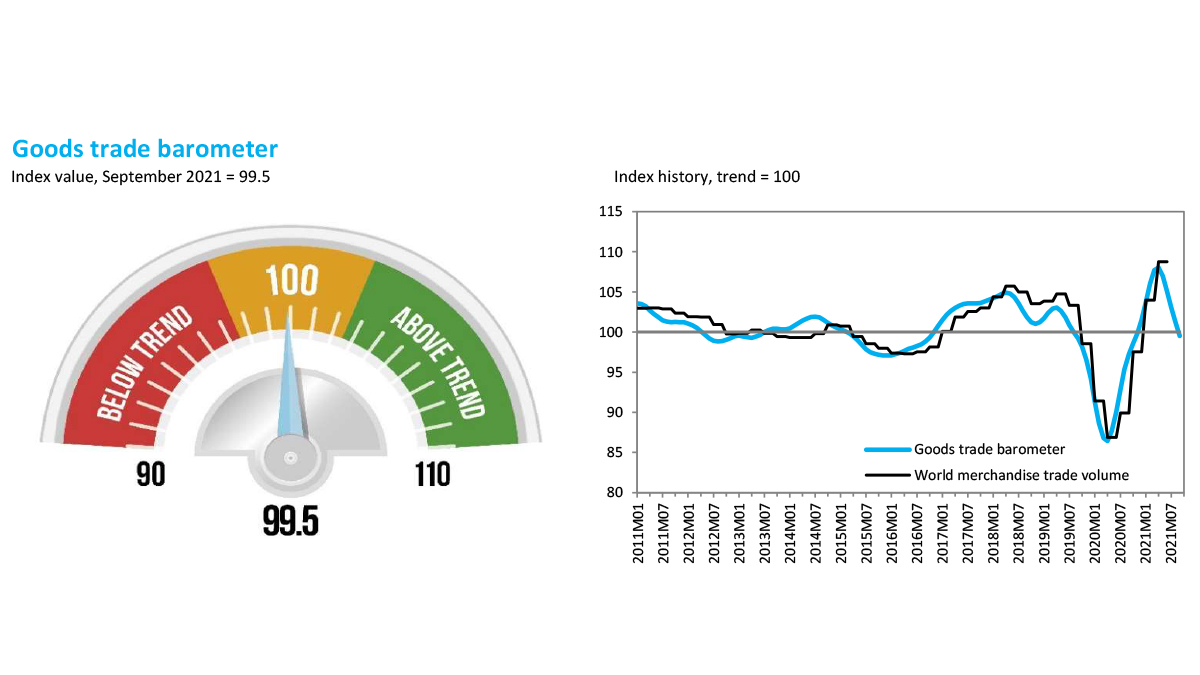El Barómetro sobre el Comercio de Mercancías indica una desaceleración del crecimiento del comercio provocada por perturbaciones en los sectores críticos #WTOstats #GlobalTrade https://t.co/aXqVqTm7zE pic.twitter.com/ND3iZD9mU6
— OMC en español (@OMC_es) November 15, 2021
15 DE NOVIEMBRE DE 2021
BARÓMETROS DE LA OMC SOBRE EL COMERCIO
El Barómetro sobre el Comercio de Mercancías indica una desaceleración del crecimiento del comercio provocada por perturbaciones en los sectores críticos
Tras una acusada recuperación después del impacto inicial de la pandemia de COVID-19, el comercio mundial de mercancías se está ralentizando, como resultado de perturbaciones experimentadas en la producción y el suministro en los sectores de importancia crítica que están frenando el crecimiento y provocando una contracción de la demanda de importaciones, según el último Barómetro sobre el Comercio de Mercancías de la OMC, publicado el 15 de noviembre.

.@OMC_es El Barómetro sobre el Comercio de Mercancías indica una desaceleración del crecimiento del comercio provocada por perturbaciones en los sectores críticos #WTOstats #GlobalTrade http://dlvr.it/SCXhWd https://twitter.com/OMC_es/status/1460261318829641730?s=20El Barómetro sobre el Comercio de Mercancías indica una desaceleración del crecimiento del comercio provocada por perturbaciones en los sectores críticos #WTOstats #GlobalTrade https://t.co/aXqVqTm7zE pic.twitter.com/ND3iZD9mU6
— OMC en español (@OMC_es) November 15, 2021
he Goods Trade Barometer is a composite leading indicator providing real-time information on the trajectory of merchandise trade relative to recent trends ahead of conventional trade volume statistics. The latest barometer reading of 99.5 is close to the baseline value of 100 for the index, indicating growth in line with recent trends.
The return to trend follows the record reading of 110.4 in the previous barometer issued in August, which reflected both the strength of the trade recovery and the depth of the pandemic-induced shock last year. Recent supply shocks, including port gridlock arising from surging import demand in the first half of the year and disrupted production of widely traded goods such as automobiles and semiconductors, have contributed to the barometer's decline.
It now appears that demand for traded goods is also easing, as illustrated by falling export orders, which further weighed down the barometer. Cooling import demand could help ease port congestion, but backlogs and delays are unlikely to be eliminated as long as container throughput remains at or near record levels.
All of the barometer's component indices were declining in the latest period, reflecting a broad loss of momentum in global goods trade. The steepest decline was seen in the automotive products index (85.9), which dropped below trend as a shortage of semiconductors hampered vehicle production worldwide. This shortage was also reflected in the electronic components index (99.6), which fell from above trend to on trend. Indices for container shipping (100.3) and raw materials (100.0) also returned to near their recent trends. Only the air freight index (106.1) remained firmly above trend as shippers sought substitutes for ocean transport.
The latest barometer reading is broadly consistent with the WTO's revised trade forecast of 4 October, which foresaw global merchandise trade volume growth of 10.8% in 2021 — up from 8.0% forecasted in March — followed by a 4.7% rise in 2022. The forecast also showed quarterly trade growth slowing in the second half of 2021 as the volume of merchandise trade volume approached its pre-pandemic trend.
The outlook for world trade continues to be overshadowed by considerable downside risks, including regional disparities, continued weakness in services trade, and lagging vaccination rates, particularly in poor countries. COVID-19 continues to pose the greatest threat to the outlook for trade, as new waves of infection could easily undermine the recovery.
The full Goods Trade Barometer is available here.
Further details on the methodology are contained in the technical note here.
No hay comentarios.:
Publicar un comentario